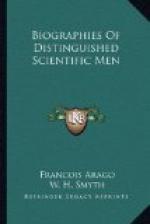The Chaldaeans, luxuriously reclining on the perfumed terraced roofs of their houses in Babylon, under a constantly azure sky, followed with their eyes the general and majestic movements of the starry sphere; they ascertained the respective displacements of the planets, the moon, the sun; they noted the date and hour of eclipses; they sought out whether simple periods would not enable them to foretell these magnificent phenomena a long time beforehand. Thus the Chaldaeans created, if I may be allowed the expression, Contemplative Astronomy. Their observations were neither numerous nor exact; they both made and discussed them without labour and without trouble.
Such is not, by a great deal, the position of modern astronomers. Science has felt the necessity of the celestial motions being studied in their minutest details. Theories must explain these details; it is their touchstone; it is by details that theories become confirmed or fall to the ground. Besides, in Astronomy, the most important truths, the most astonishing results, are based on the measurement of quantities of extreme minuteness. Such measures, the present bases of the science, require very fatiguing attention, infinite care, to which no learned man would bind himself, were he not sustained, and encouraged by the hope of attaining some capital determination, through an ardent and decided devotion to the subject.
The modern astronomer, really worthy of the name, must renounce the distractions of society, and even the refreshment of uninterrupted sleep. In our climates during the inclement season, the sky is almost constantly overspread by a thick curtain of clouds. Under pain of postponing by some centuries the verification of this or that theoretic point, we must watch the least clearing off, and avail ourselves of it without delay.
A favourable wind arises and dissipates the vapours in the very direction where some important phenomenon will manifest itself, and is to last only a few seconds. The astronomer, exposed to all the transitions of weather, (it is one of the conditions of accuracy,) the body painfully bent, directs the telescope of a great graduated circle in haste upon the star that he impatiently awaits. His lines for measuring are a spider’s threads. If in looking he makes a mistake of half the thickness of one of these threads, the observation is good for nothing; judge what his uneasiness must be; at the critical moment, a puff of wind occasioning a vibration in the artificial light adapted to his telescope, the threads become almost invisible; the star itself, whose rays reach the eye through atmospheric strata of various density, temperature, and refrangibility, will appear to oscillate so much as to render the true position of it almost unassignable; at the very moment when extremely good definition of the object becomes indispensable to insure correctness of measures, all becomes confused, either because the eye-piece gets steamed with vapour,




